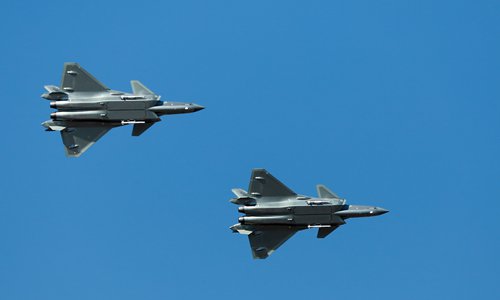Media should not over-interpret J-20 sighting near China-India border: experts
By Liu Xuanzun Source: Global Times Published: 2020/8/18 19:28:40

China's most advanced fighter jet, J-20, performs at the Chinese Air Force's "open day" event in Changchun, Northeast China's Jilin Province. This is the second time the stealth warplane opened its side missile bays and showcased its short-range combat missiles. They were first revealed at Airshow China 2018. Photo: IC
For the first time since the China-India border conflict in May, two J-20 stealth fighter jets of the Chinese People's Liberation Army (PLA) Air Force were spotted at an airport about 300 kilometers from the border region, foreign media reported. But Chinese military experts said on Tuesday that the deployments, if true, are likely part of the aircraft's regular long distance flight and environmental adaptation training, and foreign media should not over-interpret its significance in the border tensions, which have been deescalating.
Citing a commercial satellite image, Forbes reported on Monday that two J-20 fighter jets temporarily appeared at Hotan Airport in Northwest China's Xinjiang Uygur Autonomous Region, about 320 kilometers from the border region.
The report claimed that this is a sign of China's resolve to wrestle with India for influence over the region, adding that the PLA had deployed other warplanes, including H-6 bombers, to airports in Xinjiang, while India has deployed aircraft like Su-30 and Mig-29 fighter jets.
The PLA has not announced any J-20 deployment at Hotan Airport.
The J-20 is a long-range heavy fighter jet. So when deployed in Hotan, it can potentially cover many areas in Central and South Asia. But foreign media should not over-interpret its possible presence in a flashpoint region, as it is likely part of normal training on long distance flight and environment adaptation, Chinese military aviation expert Fu Qianshao told the Global Times on Tuesday.
China is a large country with many airfields in various terrains and under different climate conditions, and the J-20 needs to fly in more regions to adapt, Fu said.
The border tensions have already been deescalating, and foreign media's reports could have ulterior motives, analysts said.
Chinese Foreign Ministry spokesperson Zhao Lijian said at a routine press conference on Monday that mutual respect and support between China and India are the right direction, and in line with the long-term interests of the two countries. China is willing to work with India to enhance mutual political trust, properly manage differences, strengthen pragmatic cooperation, and safeguard the overall development of bilateral ties, he noted.
China and India have held several rounds of senior military-level talks, and agreed to disengage the frontline troops, following the border clash in June.
The J-20 is China's most advanced stealth fighter jet, comparable to the likes of the US' F-22 and F-35.
In July, India received five Rafale fighter jets from France, and Indian media boasted their capabilities as superior to the J-20. However, Chinese military experts said that the Rafale is only a third-plus generation fighter jet, and does not stand much of a chance against a stealth, fourth generation one like the J-20.
Newspaper headline: Media ‘shouldn’t over-interpret’ J-20 sighting near border